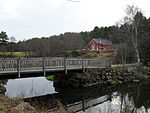Rogerson's Village Historic District
Cotton mills in the United StatesHistoric districts in Worcester County, MassachusettsHistoric districts on the National Register of Historic Places in MassachusettsIndustrial buildings completed in 1810NRHP infobox with nocat ... and 3 more
National Register of Historic Places in Uxbridge, MassachusettsUse mdy dates from March 2020Uxbridge, Massachusetts

Rogersons Village Historic District is a historic mill village in Uxbridge, Massachusetts, United States.
Excerpt from the Wikipedia article Rogerson's Village Historic District (License: CC BY-SA 3.0, Authors, Images).Rogerson's Village Historic District
Whitins Street,
Geographical coordinates (GPS) Address Nearby Places Show on map
Geographical coordinates (GPS)
| Latitude | Longitude |
|---|---|
| N 42.09333 ° | E -71.63556 ° |
Address
Whitins Street 9
01525
Massachusetts, United States
Open on Google Maps










